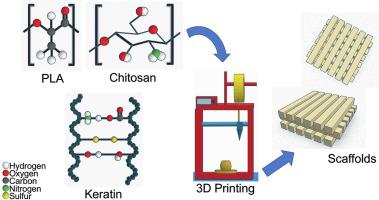当前位置:
X-MOL 学术
›
Eur. Polym. J.
›
论文详情
Our official English website, www.x-mol.net, welcomes your
feedback! (Note: you will need to create a separate account there.)
3D printing of PLA composites scaffolds reinforced with keratin and chitosan: Effect of geometry and structure
European Polymer Journal ( IF 5.8 ) Pub Date : 2020-12-01 , DOI: 10.1016/j.eurpolymj.2020.110088 L.E. Rojas-Martínez , C.G. Flores-Hernandez , L.M. López-Marín , A.L. Martinez-Hernandez , S.B. Thorat , C.D. Reyes Vasquez , A.E. Del Rio-Castillo , C. Velasco-Santos
European Polymer Journal ( IF 5.8 ) Pub Date : 2020-12-01 , DOI: 10.1016/j.eurpolymj.2020.110088 L.E. Rojas-Martínez , C.G. Flores-Hernandez , L.M. López-Marín , A.L. Martinez-Hernandez , S.B. Thorat , C.D. Reyes Vasquez , A.E. Del Rio-Castillo , C. Velasco-Santos

|
Abstract We have used polylactic acid (PLA), keratin and chitosan to manufacture 3D printable polymer composite scaffolds. The effect of two different keratin reinforcements types, i.e., keratin in fibers and particles form are studied, and the size reduction in chitosan material. Specifically, the behaviour of two different keratin configurations i.e., α-helix (from hair) and predominantly β-sheet (from chicken feathers) are used. The 3D printed composites are analysed by Fourier transform infrared (FTIR) spectroscopy, scanning electron microscopy (SEM), and dynamic mechanical analysis (DMA). Finally, cytotoxicity assays and swelling tests are performed to analyse the possible application in tissue engineering. Different keratin and chitosan sizes and shapes analyses revealed that morphology is of paramount importance for thermomechanical and cellular growth. Achieving the best results with particle-like shaped rather than with fibre-like, and chitosan materials before of size reduction. For example, the storage modulus increases around 80–85% and the cell growth results increase approximately 81–85%. In addition, swelling tests in distilled water and simulated body fluid (SBF) reveal, particle size is also important to avoid excessive swelling in the composites. Thus, the results presented evidence about the impact of reinforcement size in the studied properties the feasibility of developing biodegradable polymer composites of completely natural sources and their application for bio-scaffolds supported by the versatility of additive manufacturing.
中文翻译:

角蛋白和壳聚糖增强的 PLA 复合材料支架的 3D 打印:几何和结构的影响
摘要 我们使用聚乳酸 (PLA)、角蛋白和壳聚糖来制造可 3D 打印的聚合物复合支架。研究了两种不同的角蛋白增强类型,即纤维和颗粒形式的角蛋白的影响,以及壳聚糖材料的尺寸减小。具体而言,使用了两种不同角蛋白构型的行为,即α-螺旋(来自头发)和主要是β-折叠(来自鸡羽毛)。通过傅里叶变换红外 (FTIR) 光谱、扫描电子显微镜 (SEM) 和动态力学分析 (DMA) 对 3D 打印复合材料进行分析。最后,进行细胞毒性试验和膨胀试验,以分析在组织工程中的可能应用。不同的角蛋白和壳聚糖大小和形状分析表明,形态对热机械和细胞生长至关重要。在尺寸减小之前,使用颗粒状而不是纤维状和壳聚糖材料获得最佳效果。例如,储能模量增加约 80-85%,细胞生长结果增加约 81-85%。此外,蒸馏水和模拟体液 (SBF) 中的溶胀试验表明,粒径对于避免复合材料过度溶胀也很重要。因此,结果证明了增强材料尺寸对所研究性能的影响、开发完全天然来源的可生物降解聚合物复合材料的可行性及其在增材制造多功能性支持下的生物支架应用。
更新日期:2020-12-01
中文翻译:

角蛋白和壳聚糖增强的 PLA 复合材料支架的 3D 打印:几何和结构的影响
摘要 我们使用聚乳酸 (PLA)、角蛋白和壳聚糖来制造可 3D 打印的聚合物复合支架。研究了两种不同的角蛋白增强类型,即纤维和颗粒形式的角蛋白的影响,以及壳聚糖材料的尺寸减小。具体而言,使用了两种不同角蛋白构型的行为,即α-螺旋(来自头发)和主要是β-折叠(来自鸡羽毛)。通过傅里叶变换红外 (FTIR) 光谱、扫描电子显微镜 (SEM) 和动态力学分析 (DMA) 对 3D 打印复合材料进行分析。最后,进行细胞毒性试验和膨胀试验,以分析在组织工程中的可能应用。不同的角蛋白和壳聚糖大小和形状分析表明,形态对热机械和细胞生长至关重要。在尺寸减小之前,使用颗粒状而不是纤维状和壳聚糖材料获得最佳效果。例如,储能模量增加约 80-85%,细胞生长结果增加约 81-85%。此外,蒸馏水和模拟体液 (SBF) 中的溶胀试验表明,粒径对于避免复合材料过度溶胀也很重要。因此,结果证明了增强材料尺寸对所研究性能的影响、开发完全天然来源的可生物降解聚合物复合材料的可行性及其在增材制造多功能性支持下的生物支架应用。











































 京公网安备 11010802027423号
京公网安备 11010802027423号